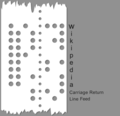URL encoding, officially known as percent-encoding, is a method to encode arbitrary data in a uniform resource identifier (URI) using only the US-ASCII...
18 KB (1,689 words) - 21:42, 1 November 2024
application vulnerable to Double percent-encoding attacks in which illegal characters are replaced by their double-percent-encoded form in order to bypass security...
11 KB (1,152 words) - 05:38, 5 August 2024
Shellcode (section Percent encoding)
JavaScript string using percent-encoding, escape sequence encoding "\uXXXX" or entity encoding. Some exploits also obfuscate the encoded shellcode string further...
25 KB (2,908 words) - 08:19, 28 June 2024
encoding is encoding of data in plain text. More precisely, it is an encoding of binary data in a sequence of printable characters. These encodings are...
22 KB (1,374 words) - 17:23, 29 October 2024
character that might otherwise not be allowed in URIs (see percent-encoding). In SQL, the percent sign is a wildcard character in "LIKE" expressions, for...
21 KB (2,057 words) - 16:41, 21 October 2024
Query string (section URL encoding)
to be percent-encoded in HTML forms to "%7E". The encoding of SPACE as '+' and the selection of "as-is" characters distinguishes this encoding from RFC...
15 KB (1,939 words) - 21:30, 6 November 2024
Base64 (redirect from Base64 (encoding scheme))
the attachment. Base64 encoding causes an overhead of 33–37% relative to the size of the original binary data (33% by the encoding itself; up to 4% more...
39 KB (3,747 words) - 21:32, 5 November 2024
percent-encoding on all other non-alphanumeric characters. For example, the key-value pairs Name: Gareth Wylie Age: 24 Formula: a+b == 21 are encoded...
10 KB (1,253 words) - 21:24, 14 October 2024
Double encoding is the act of encoding data twice in a row using the same encoding scheme. It is usually used as an attack technique to bypass authorization...
14 KB (1,898 words) - 17:01, 3 October 2022
ISO/IEC 6937 Percent-encoding Alt code Character encodings in HTML Category:Character encoding – articles related to character encoding in general Category:Character...
32 KB (3,860 words) - 10:39, 1 November 2024
already encoded, it is converted to UTF-8, and any characters not part of the basic URL character set are escaped as hexadecimal using percent-encoding; for...
17 KB (2,358 words) - 19:53, 20 June 2024
Berners-Lee, Tim; Fielding, Roy T.; Masinter, Larry 2005, pp. 12; "2.1. Percent-Encoding" Hansen, Tony; Hardie, Ted (June 2015). Thaler, Dave (ed.). Guidelines...
38 KB (4,524 words) - 15:59, 15 October 2024
Han Xin code (category Encodings)
more suitable for English text encoding or GS1 Application Identifiers data encoding. Additionally, Han Xin code can encode Unicode characters from other...
35 KB (2,956 words) - 05:21, 11 July 2024
Quoted-printable (redirect from Quoted printable encoding)
Quoted-Printable, or QP encoding, is a binary-to-text encoding system using printable ASCII characters (alphanumeric and the equals sign =) to transmit...
7 KB (977 words) - 01:09, 10 October 2023
entity encoding only on the five XML significant characters is not always sufficient to prevent many forms of XSS attacks, security encoding libraries...
32 KB (3,677 words) - 14:15, 24 October 2024
filename should be percent-encoded. Characters which are not allowed in URIs, but which are allowed in filenames, must also be percent-encoded. For example...
9 KB (1,244 words) - 02:24, 28 September 2024
Hexadecimal (section Base16 (transfer encoding))
letters Support for Base16 encoding is ubiquitous in modern computing. It is the basis for the W3C standard for URL percent encoding, where a character is...
64 KB (5,691 words) - 01:38, 2 November 2024
identifiers (URI), the use of the percent sign causes a syntax conflict, therefore it must be escaped via percent-encoding, e.g.: http://[fe80::1ff:fe23:4567:890a%25eth0]/...
62 KB (8,491 words) - 15:40, 24 October 2024
UTF-8 (redirect from UTF-8 encoding)
stored in UTF-8. UTF-8 is capable of encoding all 1,112,064 valid Unicode scalar values using a variable-width encoding of one to four one-byte (8-bit) code...
47 KB (5,002 words) - 20:34, 3 November 2024
in equivalent URIs: Converting percent-encoded triplets to uppercase. The hexadecimal digits within a percent-encoding triplet of the URI (e.g., %3a versus...
12 KB (1,333 words) - 07:23, 16 January 2024
specification would be for the CAN standard. The physical layer also specifies how encoding occurs over a physical signal, such as electrical voltage or a light pulse...
55 KB (5,646 words) - 21:23, 19 October 2024
multiple different ways. Assuming ASCII encoding, the escape sequences \x5c (hexadecimal), \\, and \134 (octal) all encode the same character: the backslash...
16 KB (1,842 words) - 11:56, 13 October 2024
four-character string is called the ASCII Compatible Encoding (ACE) prefix. It is used to distinguish labels encoded in Punycode from ordinary ASCII labels. The...
39 KB (4,433 words) - 06:16, 21 October 2024
is based on a very early version of the general URI percent-encoding rules, with a number of modifications such as newline normalization...
16 KB (1,982 words) - 00:37, 9 November 2024
be mapped to octets according to some unspecified character encoding, then percent-encoded), IRIs may additionally contain most characters from the Universal...
8 KB (849 words) - 20:32, 13 September 2024
baseball B5 Championships, a 2001 fighting game tournament %B5, the percent-encoding for the letter μ B5, a paper size of the B series defined in ISO 216...
2 KB (357 words) - 14:43, 2 July 2024
1994 Basic encoding rules (BER) - ITU-T Rec. X.690, "Specification of ASN.1 encoding rules: Basic, Canonical, and Distinguished Encoding Rules", 1994...
34 KB (4,669 words) - 11:29, 5 February 2024
carriage returns, and linefeeds cannot be directly embedded but must be percent-encoded: <a href="mailto:[email protected]?subject=This%20is%20the%20sub...
4 KB (446 words) - 23:04, 29 July 2024
value="Qm9va1RpdGxlOk5hbmN5IGRvZXNuJ3Qgc2F5ICJIZWxsbyBXb3JsZCEiIGFueW1vcmUu" /> Or percent-encoding: <input type="hidden" name="__VIEWSTATE" value="BookTitle:Nancy%20...
24 KB (2,389 words) - 16:50, 26 March 2024
data content of the URI is binary data, encoded in ASCII format using the Base64 scheme for binary-to-text encoding. The base64 extension is distinguished...
11 KB (1,280 words) - 20:22, 14 October 2024








